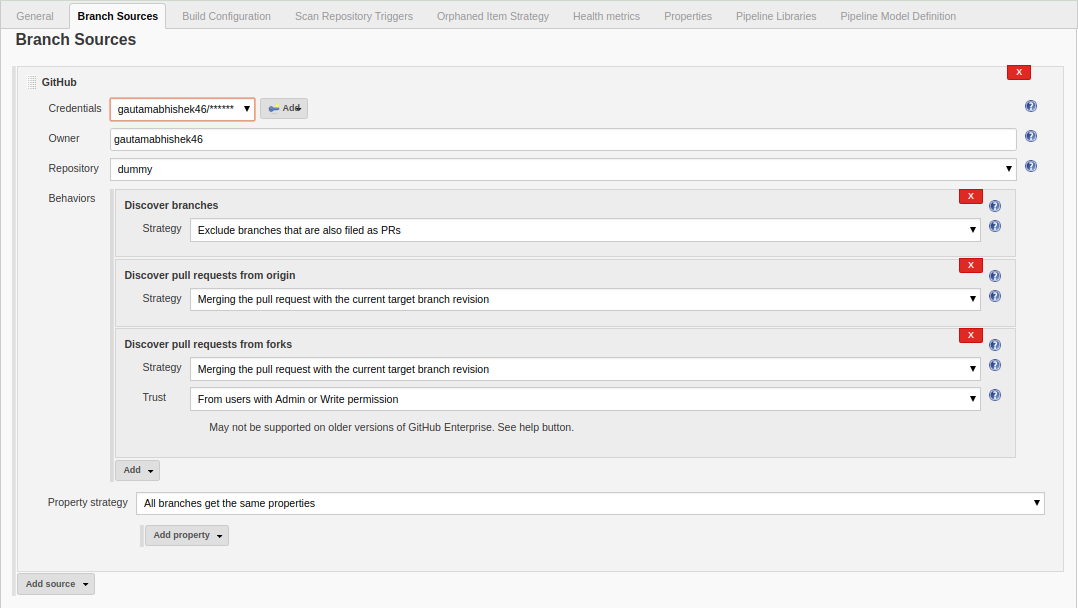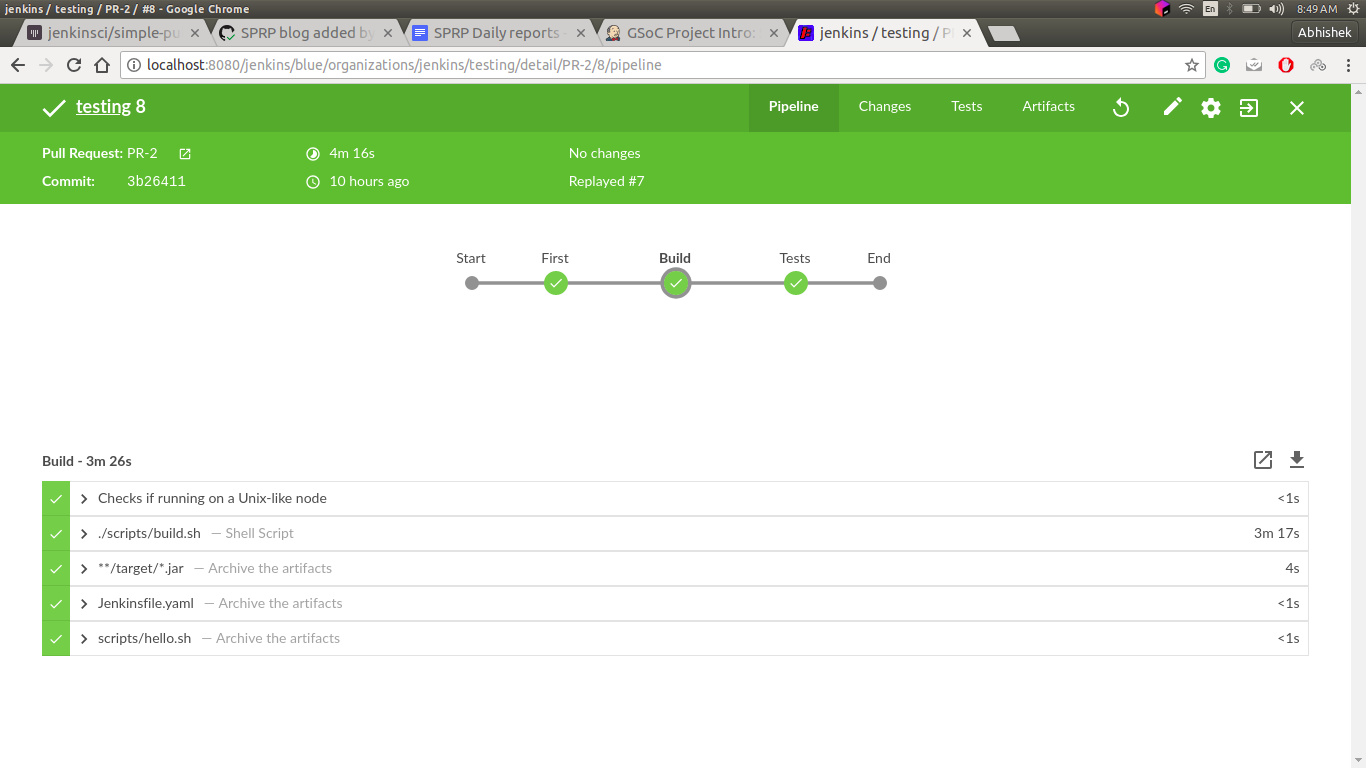About me
I am Abhishek Gautam, 3rd year student from Visvesvaraya National Institute of technology, India, Nagpur. I was a member of ACM Chapter and Google student developer club of my college. I am passionate about automation.
Mentors
-
Oleg Nenashev (Org Admin)
Project Summary
This is a GSoC 2018 project.
This project aims to develop a pull request Job Plugin. Users should be able to configure job type using YAML file placed in root directory of the Git repository being the subject of the pull request. The plugin should interact with various platforms like Bitbucket, Github, Gitlab, etc whenever a pull request is created or updated.
Plugin detects the presence of certain types of the report at conventional locations, and publish them automatically. If the reports are not present at conventional location, can specify the location using the YAML file.
Benefits to the community
-
Project administrators will be able to handle builds for pull requests more easily.
-
Build specifications for pull request can be written in a concise declarative format.
-
Build reports will be automatically published to Github, Bitbucket, etc.
-
Build status updates will be sent to git servers automatically.
-
Users will not have to deal with pipeline code.
-
If there will be no merge conflicts or build failures, the PR can be merged into target branch.
Prior work
-
Travis YML Plugin: Designed to run .travis.yml as Jenkins pipeline job. Travis-CI does not support external pull requests. Jenkins environment is different than Travis and does not always make sense to use configurations defined for other environment in Jenkins. Also maintenance of this is slowed down and last commit for this plugin was on 14 Nov 2016. Click here to check.
-
CodeShip Plugin: This plugin is designed to convert codeship "steps.yaml" and "services.yaml" to scripted pipeline code. This plugin has never been released.
-
Jenkins pipeline builder: This is a external non-Java-based tool, which cannot be easily converted to a Jenkins plugin.
Design
This plugin will be developed on the top of the MultiBranch Pipeline plugin.
For now the plugin is building branches and Pull request both using Jenkinsfile.yaml, but this plugin is inclined to use for pull requests. This will be fixed in next coding phase.
This plugin is following below steps for now:
-
clone target repo
-
checkout to target branch
-
fetch the source branch
-
merge source-branch
-
call user call user script to build the repo.
-
push changes of pull request to target branch
-
publish test reports
Plugin will start above steps if and only if the pull request is mergeable, to avoid merge conflicts while merging the source branch to target branch. Pull request’s payload contains information if the pull request changes are mergeable or not hence, the pull request is mergebale or not can also be decided by the payload of webhook also.
How to run the Plugin
See How to run the demo and set credentials, owner and repository on your own and you will be good to go.
Phase 1 features
-
Users are able to select the Jenkinsfile.yaml file as the source for the Pipeline configuration.
-
Git Push step
-
harvest results and reports (and post in the pull request)
-
junit() -
findbugs() -
archiveArtifacts()
-
-
Basic interface to parse and get build specifications from YAML file.
Things decided
-
To build the plugin on the top of multibranch pipeline plugin. As that plugin has implementation of
-
Nice interface to show different branch and pull requests build separately with use of suitable plugins like Github, Bitbucket.
-
Detect trusted revisions in a repository.
-
Publishing of build status to the repository.
-
-
Convert the YAML configuration to declarative pipeline.
-
User will provide path to the script relative to the root directory of the repository without extension (.sh or .bat) in the YAML file. The plugin will generate pipeline script to detect the platform and call .sh or .bat script.
Example: Path provided: ./scripts/hello a. On UNIX machine “./scripts/hello.sh” will be called b. On non-UNIX machine “./scripts/hello.bat” will be called.
Implementations till now
A first prototype of the plugin is ready. It supports all features of Multi-Branch Pipeline and offers the following features.
Build description is defined via YAML file stored within the SCM repo. This plugin will depend on GitHub plugin, Bitbucket plugin, Gitlab plugin if users will be using respective paltfroms for their repositories.
-
Basic conversion of YAML to Declarative Pipeline: A class YamlToPipeline is written which will load the "Jenkinsfile.yaml" and make use of PipelineSnippetGenerator class to generate Declarative pipeline code.
-
Reporting of results.
-
Plugin is using Yaml from target branch right now. (Maybe this needs some discussion, example: what if pull request contains changes in Jenkinsfile.yaml)
-
Git Push step: To push the changes of pull request to the target branch. This is implemented using git-plugin, PushCommand is used for this from git-plugin. credentialId, branch name and repository url for intracting with Github, Bitbucket, etc will be taken automatically from "Branch-Source" (Users have to fill the details of branch source in job configuration UI). (You can see How to run the demo)
Jenkinsfile.yaml example
For the phase 1 prototype demonstration, the following yaml file was used. Note that this format is subject to change in the next phases of the project, as we formalise the yaml format definition.
agent:
dockerImage: maven:3.5.3-jdk-8
args: -v /tmp:/tmp
testResultPaths:
- target/surefire-reports/*.xml
findBugs: target/*.xml
stages:
- name: First
scripts:
- ./scripts/hello
- name: Build
scripts:
- ./scripts/build
- name: Tests
scripts:
- ./scripts/test
archiveArtifacts:
- Jenkinsfile.yaml
- scripts/hello.shFrom the yaml file shown above, the plugin generates the following pipeline code:
pipeline {
agent {
docker {
image 'maven:3.5.3-jdk-8'
args '-v /tmp:/tmp'
alwaysPull false
reuseNode false
}
}
stages {
stage('First') {
steps {
script {
if (isUnix()) {
sh './scripts/hello.sh'
} else {
bat './scripts/hello.bat'
}
}
}
}
stage('Build') {
steps {
script {
if (isUnix()) {
sh './scripts/build.sh'
} else {
bat './scripts/build.bat'
}
}pipeline
}
post {
success {
archiveArtifacts artifacts: '**/target/*.jar'
archiveArtifacts artifacts: 'Jenkinsfile.yaml'
archiveArtifacts artifacts: 'scripts/hello.sh'
}
}
}
stage('Tests') {
steps {
script {
if (isUnix()) {
sh './scripts/test.sh'
} else {
bat './scripts/test.bat'
}
}
}
post {
success {
junit 'target/surefire-reports/*.xml'
}
always {
findbugs pattern: 'target/*.xml'
}
}
}
}
}Coding Phase 2 plans
-
Decide a proper YAML format to use for Jenkinsfile.yaml
-
Create Step Configurator for SPRP plugin. Jenkins-51637. This will enable users to use Pipeline steps in Jenkinsfile.yaml.
-
Automatic indentation generation in the generated Pipeline SnipperGenerator class.
-
Write tests for the plugin.
How to reach me
-
Email: gautamabhishek46@gmail.com
-
Gitter room: https://gitter.im/Jenkinsci/simple-pull-request-job-plugin


